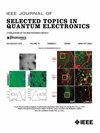Oxide-Aperture Scaling of Cryogenic Microcavity Surface Emitting Laser for Ultrafast Optical Link
IF 5.1
2区 工程技术
Q1 ENGINEERING, ELECTRICAL & ELECTRONIC
IEEE Journal of Selected Topics in Quantum Electronics
Pub Date : 2025-02-11
DOI:10.1109/JSTQE.2025.3540892
引用次数: 0
Abstract
The growth of cryogenic computing including quantum computers and superconducting processors requires energy-efficient data links capable of operating between room and cryogenic temperatures. In this work, we report the first high-speed microcavity laser achieved by scaling the oxide-aperture diameter of Cryo-VCSEL from 6.8 μm (typical cavity size) to 1.8 μm (microcavity) for ultrafast optical links. We investigated the scaling of laser cavity size through measurements of the oxide-aperture diameter and calculations of laser spectrum modal separation. The microcavity Cryo-VCSEL demonstrates an ultrahigh bandwidth, f-3dB > 50 GHz at a minimal bias current of 1mA (I/ITH = 3.5x) at 40 K. Furthermore, it achieves a 112 Gbps PAM-4 data rate with TDECQ = 3.30 dB at I = 6 mA, revealing that microcavity lasers are a viable solution for ultrafast data links, achieving energy efficiency of less than 10 fJ/bit.超高速光链路低温微腔面发射激光器的氧化孔径缩放
包括量子计算机和超导处理器在内的低温计算的发展需要能够在室温和低温之间运行的节能数据链路。在这项工作中,我们报告了通过将Cryo-VCSEL的氧化物孔径直径从6.8 μm(典型腔尺寸)缩放到1.8 μm(微腔)来实现超高速光链路的高速微腔激光器。我们通过测量氧化物孔径直径和计算激光光谱模态分离来研究激光腔尺寸的标度。该微腔Cryo-VCSEL在40 K时,在最小偏置电流为1mA (I/ITH = 3.5x)的情况下,显示出超高带宽,f-3dB > 50 GHz。此外,它在I = 6 mA时实现了112 Gbps的PAM-4数据速率,TDECQ = 3.30 dB,表明微腔激光器是超高速数据链路的可行解决方案,实现了低于10 fJ/bit的能量效率。
本文章由计算机程序翻译,如有差异,请以英文原文为准。
求助全文
约1分钟内获得全文
求助全文
来源期刊

IEEE Journal of Selected Topics in Quantum Electronics
工程技术-工程:电子与电气
CiteScore
10.60
自引率
2.00%
发文量
212
审稿时长
3 months
期刊介绍:
Papers published in the IEEE Journal of Selected Topics in Quantum Electronics fall within the broad field of science and technology of quantum electronics of a device, subsystem, or system-oriented nature. Each issue is devoted to a specific topic within this broad spectrum. Announcements of the topical areas planned for future issues, along with deadlines for receipt of manuscripts, are published in this Journal and in the IEEE Journal of Quantum Electronics. Generally, the scope of manuscripts appropriate to this Journal is the same as that for the IEEE Journal of Quantum Electronics. Manuscripts are published that report original theoretical and/or experimental research results that advance the scientific and technological base of quantum electronics devices, systems, or applications. The Journal is dedicated toward publishing research results that advance the state of the art or add to the understanding of the generation, amplification, modulation, detection, waveguiding, or propagation characteristics of coherent electromagnetic radiation having sub-millimeter and shorter wavelengths. In order to be suitable for publication in this Journal, the content of manuscripts concerned with subject-related research must have a potential impact on advancing the technological base of quantum electronic devices, systems, and/or applications. Potential authors of subject-related research have the responsibility of pointing out this potential impact. System-oriented manuscripts must be concerned with systems that perform a function previously unavailable or that outperform previously established systems that did not use quantum electronic components or concepts. Tutorial and review papers are by invitation only.
 求助内容:
求助内容: 应助结果提醒方式:
应助结果提醒方式:


